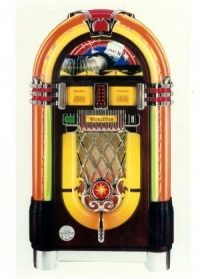Wurlitzer
In 1946 Wurlitzer introduced its Model 1015 jukebox, designed by industrial designer Paul Fuller. Replete with chrome, garish colors and bubbling lights, it became a classic and ultimate cultural typeform, dispensing music in every diner across the country for the next fifteen years. The first public "music boxes" were called Nickelodeons. In 1900 there were 2000 of them in Brooklyn alone. The term was a combination of "nickel" and "melody." These coin-operated phonographs, invented in 1889 by Louis Glass, used ear-tubes like musical hookah pipes, in order to hear the faint music. In 1927, the Automatic Music Company of Grand Rapids, MI, marketed the first contemporary "Automatic Phonograph," a coin-operated, multiple-selection phonograph which amplified the sound electrically, similarly to the way the radio does. They soon became informally known as "jukeboxes," as they were often used in the "juke joints" (sugar cane cutter hangouts) in the South. The Rudolph Wurlitzer Company (founded 1856) introduced its first "jukebox" in 1934, the 10-selection Model P-10, with a window showing the changing mechanism. The name "jukebox" (See PR 1927) only became accepted by the industry in 1939, when big band leader Glenn Miller was quoted using the term by Time magazine. In 1955, Raymond Loewy put the design curse on jukeboxes (as well as the US automotive industry), by calling Detroit's new cars "jukeboxes on wheels" in a speech to the Society of Automotive Engineers. Wurlitzer produced jukeboxes until the product became passé in the 1960s, and discontinued US production in 1974, but its German subsidiary continues production today.
